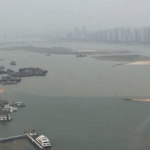14th Annual Living Lakes Conference in Nanchang China: Challenges and Reflections
This past November, I represented Living Lakes Canada and Wildsight at the 14th annual Living Lakes Conference in Nanchang, China. I was invited, along with Alex and Catherine Salki of Living Lakes Canada member organization, the Lake Winnipeg Foundation, to present our work on water stewardship in lake communities with a special focus on the Columbia River Basin and the Lake Winnipeg Basin.
Attended by 350 delegates from 33 countries spanning 5 continents, the conference was co-hosted by the Jiangxi Provincial Government, Jiangxi Academy of Science, Global Nature Fund, Ramsar, Jiangxi Academy of Sciences and Mountain River Lake Sustainable Development (MRLSD). Although the conference theme was “Lakes in densely populated regions: Balance between people and nature,” there was significant information exchanged on the protection of lakes and wetlands worldwide and sharing new approaches for successful management with a common understanding for the need and urgency to foster the protection of lakes and wetlands worldwide.
In preparation for the conference, I met with Bob Sandford, the Canadian Chair for the UN Decade for Water, to better understand where China is situated globally with regard to their freshwater. Bob provided me with excerpts from Elizabeth Economy’s book, “The River Runs Black: The Environmental Challenge To China’s Future,” as well as Michael Buckley’s book, “Meltdown in Tibet: China’s Reckless Destruction Of Ecosystems From The Highlands of Tibet to The Deltas of Asia.”
Regardless of the reading preparedness, it was still quite shocking to see Nanchang City, population seven million, through my bus window and witness the kilometers upon kilometers of empty highrises awaiting relocated arrivals from rural areas. Building cranes stretched the horizon as far as the eye could see. In 2004 it was estimated that over 400,000,000 people will be relocated before 2030, while “China will build half of all the buildings that will be constructed in the entire world, but they will be two and a half times less energy efficient.”
We were bussed across Nanchang from our Living Lakes conference, to attend the opening speeches of another conference being held at the same time. “The Third World, Low-Carbon, Ecology and Green Food Forum.” Apparently, we were the “green” component of this economic development forum. We sat with 4000 delegates and listened to various dignitaries from China and abroad, including Marion Hammerl, president of Global Nature Fund, speak to the importance of ecological stewardship as the premise of a green economy. We were told by Chinese officials about China’s economic development plan, as China entered its newly declared “Ecological Civilization,” to quadruple the economy by 2030, at which time China’s prosperity would allow it to address it’s ecological woes. We were shown a film entitled “Chinese Propaganda film,” in which the landscape of China was airbrushed as lush green fields, clear blue skies, clean water and cities and happy citizens. It was a shocking juxtaposition to look out of the conference centre window and not be able to see across the street because of the smog.
I met a young Chinese water scientist who had lived in Germany for five years in order to complete his Phd. I asked him what he and his peers thought about the ongoing propaganda of a green, clean and ecologically healthy future for China, being disseminated not only at this conference, but also on the TV in our hotel rooms and throughout all of the publications we received. It’s important to note here that the levels of pollution are currently so extreme that 50% of China’s freshwater is completely contaminated. China currently has only 6% of the world’s fresh water but will have one quarter of the world’s population by 2025. He smiled and answered that everybody markets with propaganda, not only in China but in Canada, the USA and around the world. “It is normal,” he said.
On a field trip to Puyang Hu Lake, we walked through a very tidy “model” village. We were shown the town freshwater well and the rice paddies acting as sewage filters for the river and lake. The village had many posters showing the merits of moving from the country to the city. At Puyong Lake Nature Reserve, we were able to see Chinese campers from the growing middle class, who were testing their new off-road vehicles and dirtbikes along the foreshore of the lake.
Officials are concerned about what is happening with the lake. Because of intensive dredging of sand in the lake’s tributary to make construction cement for Nanchang city, the lake level has started to drop and it’s unlikely it will be able to provide for the city’s water needs. Puyong lake is of international significance for migrating waterfowl from Europe and resident freshwater dolphins. Numbers have declined and during our visit we did not see any sign of them.
According to Elizabeth Economy, “Two thirds of China’s 660 cities have less water than they need and 110 already suffer severe shortages and water use is increasing. More than 75% of the riverwater flowing through China’s cities is unfit for drinking or fishing. Aquifers below 90% of Chinese cities are polluted. Approximately 700,000,000 people drink water contaminated by animal or human waste. Polluted rivers make for polluted oceans. About 80% of the East China Sea is rated as unsuitable for fishing.” In an attempt to replenish surface water supplies for drinking and agricultural uses, the Chinese government has recently announced an ambitious environmental engineering project—cloud seeding with silver-iodide crystals to increase precipitation.
There were numerous presentations from young water scientists of the Jiangxi Science Academy outlining some of the water problems and what needed to be done. They were even able to speak about the ecological devastation caused by the Three Gorges Dam, the lessons learned and actions that should be taken for mitigation. This type of openness was not case eight years ago at the last Living Lakes gathering in China. Conference delegates from Mongolia, Japan, Germany, England, Peru, Bolivia, Ecuador, Mexico, Turkey, Jordan, South Africa, Pakistan, New Zealand, Australia, Hungary and Canada, to name a few, were all able to share the lake and wetland challenges that they were facing in their own communities. There was a sense of solidarity, creating moral support as these passionate and committed water stewards shared stories of their diminishing lakes and wetlands.
Information presented by conference delegates felt quite onerous and heavy in terms of the escalating challenges that we have and will continue to face as global citizens. It is estimated that China will emit twice the volume of CO2 than all OEDC countries combined by 2030. As a result of these emissions, climate change modeling has indicated that there will be 30% decline in precipitation in China’s three major river basins, resulting in a 40% decline in China’s wheat, rice and corn yields. With the rising sea levels, Shanghai could be submerged by 2050. Yet somehow, we harbour this notion that China’s problems are not Canada’s. China is attempting to address its current and future environmental, resource, energy and food security problems by purchasing huge Canadian wheat farms, oil and coal companies. Coal continues to fuel 70% of China’s energy needs, in turn producing 90% of its SO2 and 50% of its particulate matter, as well as much of its mercury emissions, which travel all over the world. Elisabeth Economy references an academic article published by Dr. David W. Schindler et al., which describes how some of the carcinogenic toxaphene now contained in the snows of the Wapta Icefield at the headwaters of the Bow River in the Canadian Rockies also come from China.
Needless to say, we returned home overwhelmed and not quite able to process what we had seen, much less determine what meaningful action we could take within our own organizations. Perhaps the most poignant conclusion after all of the scientific papers were presented is that the human caused degradation of lakes, rivers and wetlands is a universal challenge and equally universal are the solutions which call for holistically managed aquatic ecosystems. This includes strong water legislation, enforcement, governance and integrated watershed management of land, water and air ecosystem components. Joint regional, national and transboundary efforts to resolve water issues will also require transparency, shared science, data, monitoring techniques and multi sector co-operation.
One thing is for certain—if ENGO’s hope to make a difference, it will not be enough to accept and apply a business-as-usual approach. The protective, no-feather-ruffling style of functioning is a disservice, a form of self-greenwashing and/or worse, a delusion. It is hard to find the answers regarding how to ensure that our work is making a difference and helping us deal with the immense challenges posed by climate change. We will once again need to be introspective, ask ourselves the right questions and cross exam the usefulness of our own small sphere of NGO influence.
-Kat Hartwig, Executive Director, Living Lakes Canada





